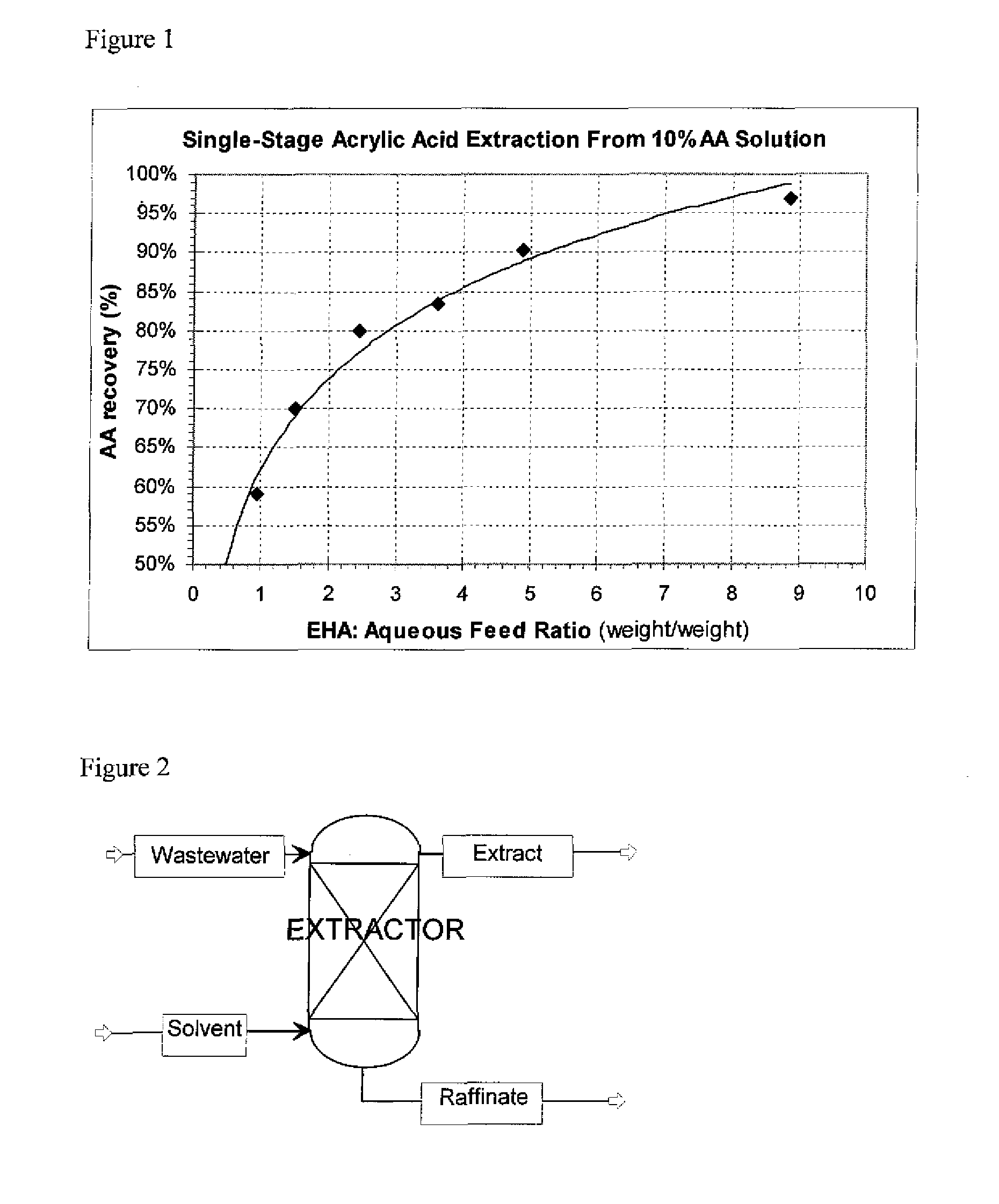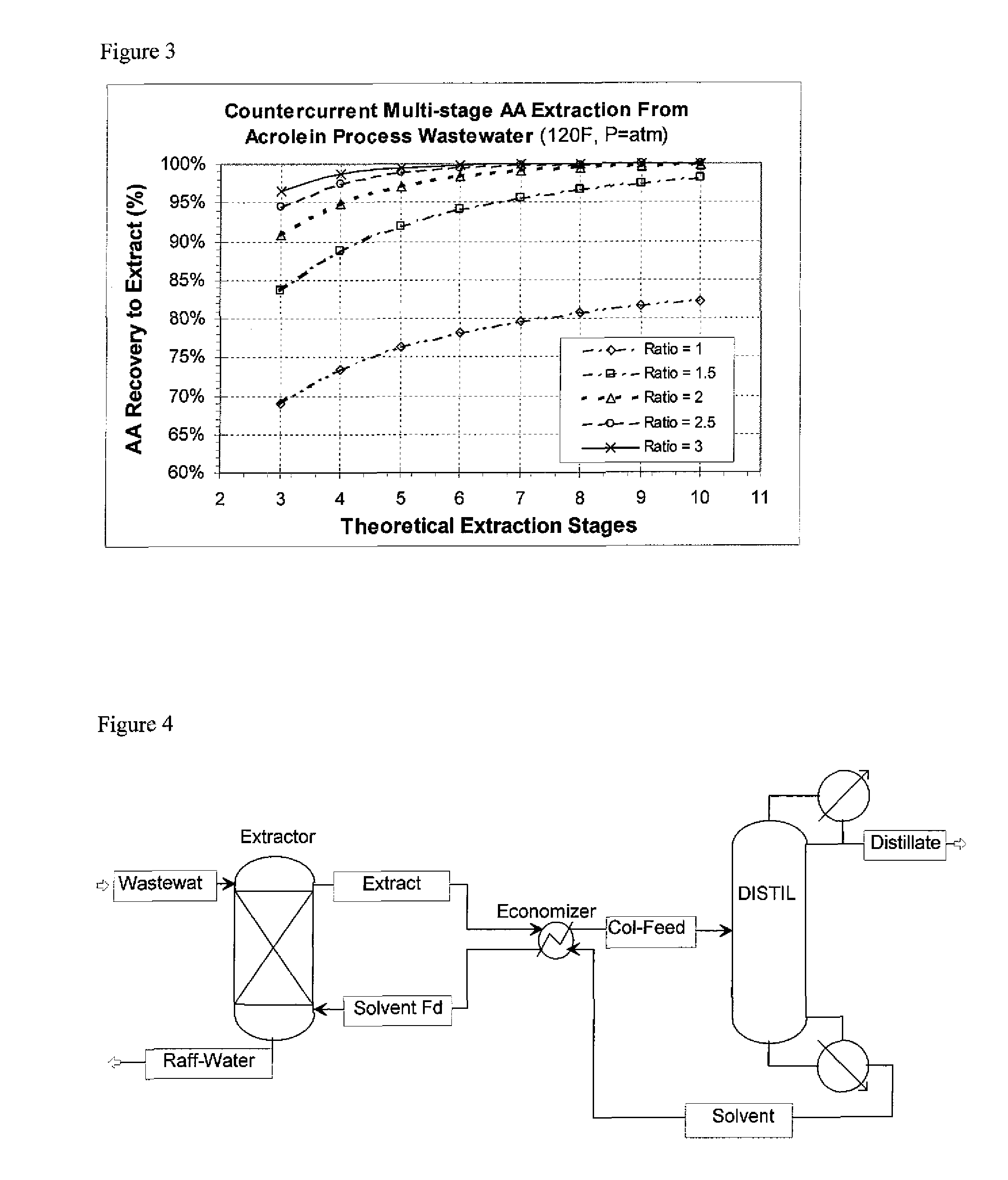Method for recovering carboxylic acids from dilute aqueous streams
- Summary
- Abstract
- Description
- Claims
- Application Information
AI Technical Summary
Benefits of technology
Problems solved by technology
Method used
Image
Examples
example 1
Single-Stage AA Extraction From Acrolein Process Wastewater Using EHA As The Solvent
The aqueous AA solution was a wastewater stream from an acrolein manufacturing process containing the following (compositions given in weight %; the balance is water).
Acrylic Acid7.23%Maleic acid1.05%Acetic Acid1.36%Allyl Alcohol0.07%Acrolein0.06%Acrolein dimer0.04%
The solvent used was 2-ethylhexanoic acid from Alfa Aesar. Initial trails at ambient temperature resulted in a quasi-emulsified mixture which only partially separated; an intermediate “rag” layer remained. It was found that subsequent heating of the mixture to 45°-50° C. allowed the two liquid phases to separate cleanly after several minutes. Using a 1.6:1 EHA:Aqueous feed weight ratio at 50° C. resulted in 73% recovery of AA to the organic phase.
examples 2-7
Single-Stage AA Extraction from Water Using EHA as the Solvent
Aqueous AA solutions, 10 wt % AA in distillated water were contacted with EHA solvent. Single-stage extractions were run at approximately 50° C. Six EHA:Aqueous feed mass ratios were run, ranging from 1:1 to 9:1. The partitioning of AA between the resulting 2 liquid phases and mass balances were determined. The results are shown in Table 1, and plotted in FIG. 1.
TABLE 1Example234567EHA:Aqueous1.01.53.62.54.98.9Feed RatioAverage AA59%70%83%80%90%97%recovery toExtract
In the following examples, the process conditions and material balances were determined by computer simulation, using the Aspen Plus process simulator, with the non-random two-liquid (NRTL) thermodynamic model used to calculate mixture properties, component separations, etc. The NRTL component binary pair parameters were based on values regressed from literature and experimental data, where available, and predicted using the Aspen “PCES” property component esti...
example 8
Countercurrent Multi-Stage AA Extraction from Acrolein Process Wastewater
A simulation was run of contacting the wastewater stream of Example 1 counter-currently with EHA in an extraction column providing several theoretical stages of contacting. The column operating at ambient pressure. The simulation had the wastewater fed to the top of the column, and the EHA solvent fed to the bottom of the column. The solvent-rich extract exited the top of the column, and the denser water-rich raffinate exited the bottom of the column. The wastewater feed stream was at 120° F.; the EHA solvent feed temperature is 120° F. The process flowsheet is depicted schematically FIG. 2. The number of theoretical extraction stages was varied, from 3 to 10. The % recovery of acrylic acid (acrylic acid extracted from the feed into the solvent extract) vs. the number of theoretical extraction stages for solvent to feed weight ratios of 1:1, 1.5:1, 2:1, 2.5:1 and 3:1 were run. The results are shown in FIG. 3.
PUM
| Property | Measurement | Unit |
|---|---|---|
| Temperature | aaaaa | aaaaa |
| Temperature | aaaaa | aaaaa |
| Temperature | aaaaa | aaaaa |
Abstract
Description
Claims
Application Information
 Login to View More
Login to View More - R&D
- Intellectual Property
- Life Sciences
- Materials
- Tech Scout
- Unparalleled Data Quality
- Higher Quality Content
- 60% Fewer Hallucinations
Browse by: Latest US Patents, China's latest patents, Technical Efficacy Thesaurus, Application Domain, Technology Topic, Popular Technical Reports.
© 2025 PatSnap. All rights reserved.Legal|Privacy policy|Modern Slavery Act Transparency Statement|Sitemap|About US| Contact US: help@patsnap.com



